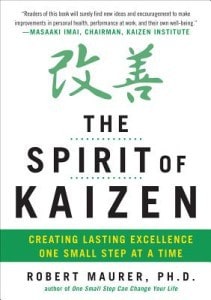As we enter the new year, it's a great time to reflect back on 2012 – what worked and what didn't work… what do we plan to do differently in 2013? Those are some of the core questions found on a “strategy A3” as often used in the Lean methodology.
Individuals and organizations often try to find one major improvement – a “home run,” if you will. Someone might say, “I want to lose 50 pounds,” or “We need to develop a new product that doubles revenue.” Goals like that might be scary… and for good reason, as described in the new book by Robert Maurer, PhD: The Spirit of Kaizen: Creating Lasting Excellence One Small Step at a Time.
There's one action that can lead to lots of little improvements (and, eventually, to innovation) – the adoption of the “kaizen” mindset.
Robert Maurer is a faculty member in behavioral sciences at UCLA and the University of Washington. I previously reviewed his earlier book One Small Step Can Change Your Life: The Kaizen Way and did a podcast interview with him about that book, which primarily focused on the application of “kaizen” (Japanese for “good change”) style improvement approaches to his patients and their personal lives.
He wrote about how “small steps” in the style of kaizen (as practiced in the industrial world) could help individuals lose weight and change other personal behaviors. Instead of telling an overweight patient to start exercising an hour a day (which would cause the “fight or flight” instinct to kick in because it's a scary request), Dr. Maurer would ask a person to start exercising by just walking in place for the length of 30 seconds. This wasn't as scary, so people would try that small step, building enthusiasm and confidence that would allow them to build up to an hour a day. The success rate from starting small was much higher.
In his latest book, Maurer brings these ideas back to the workplace with stories about how this same kaizen mindset can be applied to improve quality, boost morale, reduce costs, reduce healthcare expenses, and more. The book is focused more on businesses, hospitals, and organizations rather than individuals – but the understanding of how change happens is based on our own personal brain chemistry and evolution. Maurer calls kaizen “a doable path to innovation” because we're more likely to have big changes occur when we start small. I wrote about similar thoughts from a Japanese hospital CEO back in November.
Maurer describes how the “reptile brain” (the amygdala) in the more complex human brain can help us when it's kicking in the powerful “fight or flight” response that's necessary when we are in real danger. The problem with the reptile brain is that the fight or flight response kicks in even when we merely imagine a dangerous situation or something threatening (such as losing one's job)… and this reptile brain shuts down higher-level thought processes and capabilities. So, instead of saying that people shouldn't be afraid of change, we should recognize that large changes (or “radical changes,” as he calls them) are scary… it's in our DNA… and we need to work to make changes smaller and, therefore, less scary.
In Chapter 1, Maurer writes of a doctor's office that he taught to use Kaizen. They were, initially, asking for innovation. But Maurer suggested that each person think about “the smallest step possible” that would improve the office. He had two rules:
- The step couldn't cost anything (resources were tight in the struggling office)
- The idea had to benefit the customer (the patient)
Maurer cites the American approach of “Training Within Industry” and the teachings of an American, W. Edwards Deming, in laying out the principles that allowed the clinic to dramatically reduce patient no-show rates and improve patient satisfaction – lots of little improvements led to a successful practice. These aren't just Japanese practices. They are human practices that work around the world.
The clinic was hesitant to use kaizen, as are many, because the improvements seem trivial and insignificant. Kaizen and continuous improvement approaches aren't sexy or exciting… but they work. Maurer writes:
“These steps are so small that they may seem useless, but that's why they work. If the amygdala is like an alarm system, small steps are like cat burglars…. Your alarm never goes off…. You retain access to your rational, creative thoughts.”
The Spirit of Kaizen is a short book (I read it on my flight back from Japan, and it didn't take the whole trip). Still, it's full of examples that reinforce the core kaizen principles and our understanding of how people can embrace and initiate change for the betterment of customers (patients), themselves, and their organizations. The main themes are a bit repetitive, but they're solid, and they work:
Start small (the smallest step possible), expect to stumble along the way, and continue striving to get better.
If there's one new habit to embrace in 2013, let it be kaizen! What's the smallest possible step you can take toward the goal of having a kaizen mindset or a kaizen culture?
I'll share more about the book in future posts. If you're interested in kaizen, also check out my latest book, Healthcare Kaizen.
What do you think? Please scroll down (or click) to post a comment. Or please share the post with your thoughts on LinkedIn – and follow me or connect with me there.
Did you like this post? Make sure you don't miss a post or podcast — Subscribe to get notified about posts via email daily or weekly.
Check out my latest book, The Mistakes That Make Us: Cultivating a Culture of Learning and Innovation:











Maurer’s thinking, that small incremental changes are much more acceptable to humans because of our wiring, very much fits with my experiences. My first venture into lean in healthcare was with a hospital that tried to copy ThedaCare’s model of Value Steam Analyses, then followed by week-long Rapid Improvement Events (big changes in a short time frame). The resistance by the frontline staff, even though they were the ones making the changes, was very strong, but we plowed through it in spite of the resistance. This eventually resulted in an angry meeting with managers who essentially told upper management and us lean coaches that they had “had enough.”
I’m now approaching it differently at another hospital – much more deliberately – with most projects selected by the people in the areas, starting off with perhaps a half or full day to walk the gemba, map, and do some thorough root cause analysis. Then, meeting often enough afterwards to review the results of countermeasures and plan further. It’s more of a PDCA custom fit to each project. The managers and frontline staff love it and the results have been very good, even just 1 year into this. We’re now making plans to launch local A3s by areas, and we’ll PDCA this as we go also.
I don’t want to say that the standard “VSA/RIE” model is a poor one. Perhaps for some health systems it works well. My advice would be, if using that approach, to really have a finger to the pulse of the organization to know how staff is truly feeling about it. And don’t take verbal responses at face value.
I like Maurer’s thinking.
Mark – thanks for sharing your approach and your experiences. I’d agree with your statement that the VSA/RIE model isn’t a poor one… finding the right approach for a particular organization at a point in time depends on a lot of factors, including things that are out of the the control of local lean specialists (like pressures on the organization, the environment created by senior leadership, etc.).
I’m glad to hear the “small steps” approach is working well. Good luck with things here in 2013!
Dr. Robert Maurer adds a very important piece of knowledge. Tying kaizen to the “fight or flight” response allows us to right size our projects. For example, back in 2007, when we took a full mouth series of x-rays, we found that some of the x-ray shots had to be taken more than one time before getting the standard results.
We tried to standardize and train in all the x-ray shots at once. The project seemed too big for the team members and created some confusion. I suggested that we reduce the project to include only one group of x-rays consisting of four “bitewing x-rays”-less confusion, but no smooth implementation! Then we reduced the project to improving only one bitewing shot. Everything went smoothly and we were able to go back, and with little effort, improve the rest of the x-rays.
With trial and error, we can adapt the size of the project to the comfort zone (no fight-or-flight) of the team members. I find that important!
As for the Rapid Improvement Events, or Kaizen events, we can also tie them to the “fight-or-flight” response. If a group of people is comfortable with change, and dissatisfied with the current condition of a process, I think that little kaizen steps won’t satisfy them. They might prefer to stop and do an event instead.
In General, however, our experience agrees with both Mark, small steps lead to FASTER implementation.
Thanks
Sami
Did you mean “but now smooth implementation,” Sami?
No, Mark. It got smooth at the smallest level–when we improved only one x-ray shot at a time. Back then, you mentioned in your post that you saw TWI Job Instruction forms; that was the x-ray improvement project.
OK, I see better now… you’re saying going to smaller batches was better but going to the smallest batch (one) was best.
As always, thanks for sharing your experiences and lessons learned.
I’m sorry I wasn’t able to be in Jacksonville for New Year’s Day… I watched my Northwestern Wildcats win the Gator Bowl from the comfort of my couch at home. I think NU brought a lot of fans for a boost to the local economy.
Happy New Year!
[…] I recently wrote about Robert Maurer’s new book in this post: “Start 2013 with “The Spirit of Kaizen” […]